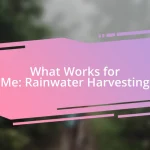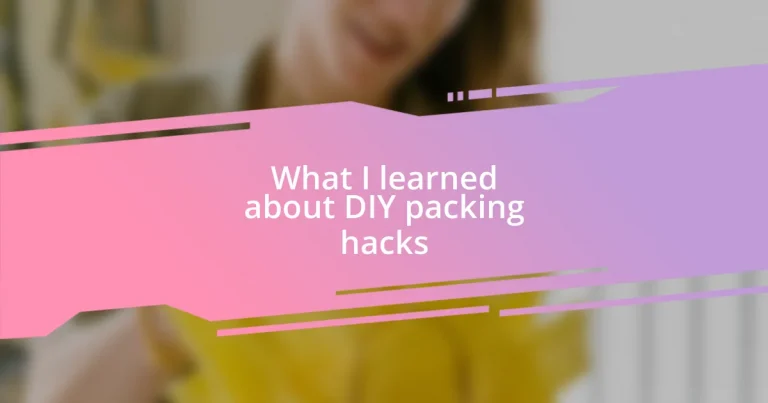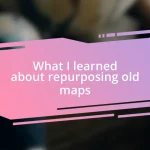Key takeaways:
- Utilizing creative storage solutions, like sunglasses cases for chargers and rolling clothes, can significantly enhance organization and maximize space when packing.
- Key packing materials, including packing cubes for organization, bubble wrap for fragile items, and zip-top bags for versatile storage, are essential for efficient travel.
- Implementing smart labeling strategies, such as color-coding and detailed notes, streamlines the packing process and helps ensure that essential items are not forgotten.
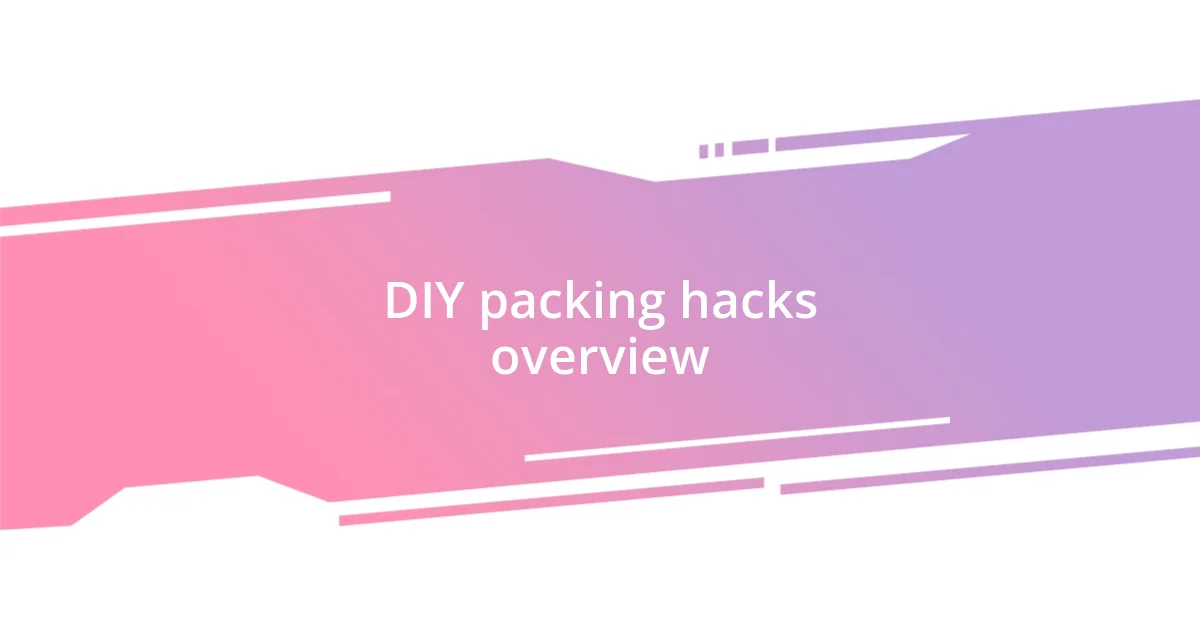
DIY packing hacks overview
When I first delved into the world of DIY packing hacks, it felt like I had uncovered a treasure chest of practical solutions. One hack that really surprised me was using empty sunglasses cases to store chargers and small electronics. It was such a simple shift, but it helped me keep my bag organized and avoided that frustrating mess of tangled cords.
I often find myself reflecting on the packing challenges I’ve faced during last-minute trips. I remember frantically trying to fit everything into my suitcase and wishing I had known that rolling clothes rather than folding them saves so much space. It’s these little lessons that make a world of difference when you’re packing, and they turn a stressful experience into something manageable and even enjoyable.
Have you ever struggled with bringing back souvenirs without losing precious space? I certainly have! I learned to utilize the spaces within my shoes to pack smaller items, which added both organization and creativity to my packing process. It’s truly fascinating how a few simple hacks can transform your approach to travel.
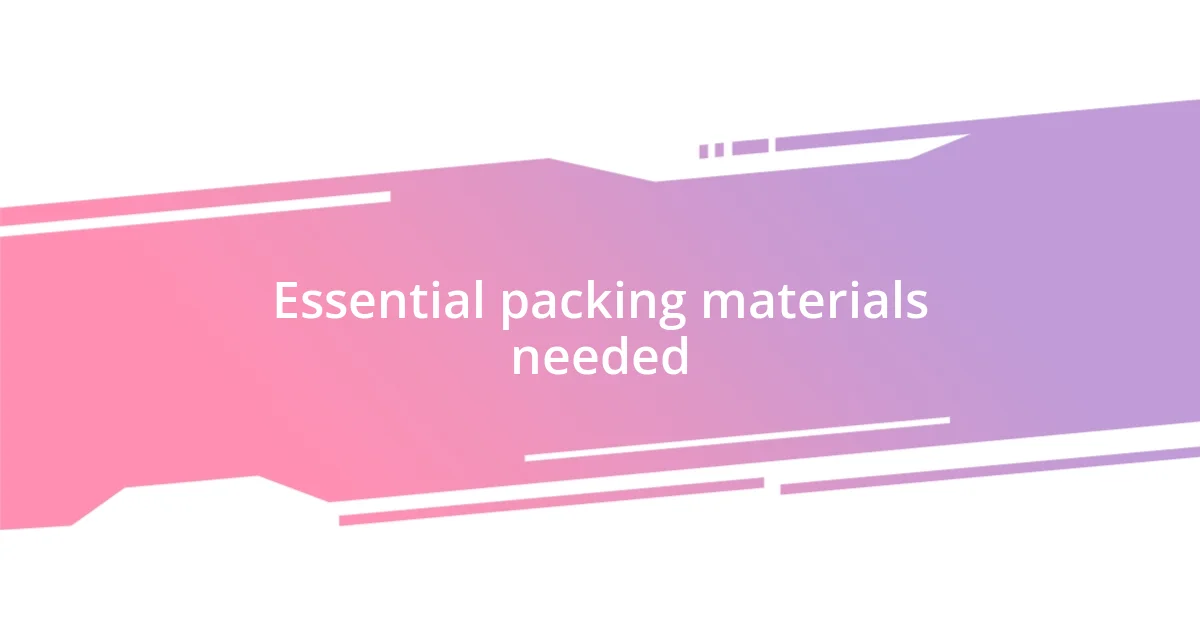
Essential packing materials needed
When it comes to packing, having the right materials can make a significant difference. I can’t emphasize enough how useful packing cubes have been for my travels. They not only help to compress my clothing but also ensure that I can easily locate specific items without tearing my bag apart, which is a real lifesaver during rushed moments at the airport.
Another essential item I never travel without is bubble wrap. You might wonder why it’s so important, right? Well, I once had a heart-stopping moment when a fragile souvenir I had bought abroad arrived at my destination in pieces—lesson learned! Now, I wrap delicate items in bubble wrap to provide that extra layer of protection, ensuring my treasures survive the journey.
Finally, I always carry a good set of zip-top bags. They might seem mundane, but trust me, they’re versatile! I use them to store toiletries, snacks, or even to keep my electronics dry on outdoor adventures. The ability to keep things separate and organized can’t be underestimated, especially when you’re trying to find your essentials amid the chaos of travel.
| Packing Material | Purpose |
|---|---|
| Packing Cubes | Organization and space-saving |
| Bubble Wrap | Protection for fragile items |
| Zip-Top Bags | Versatile storage for various items |
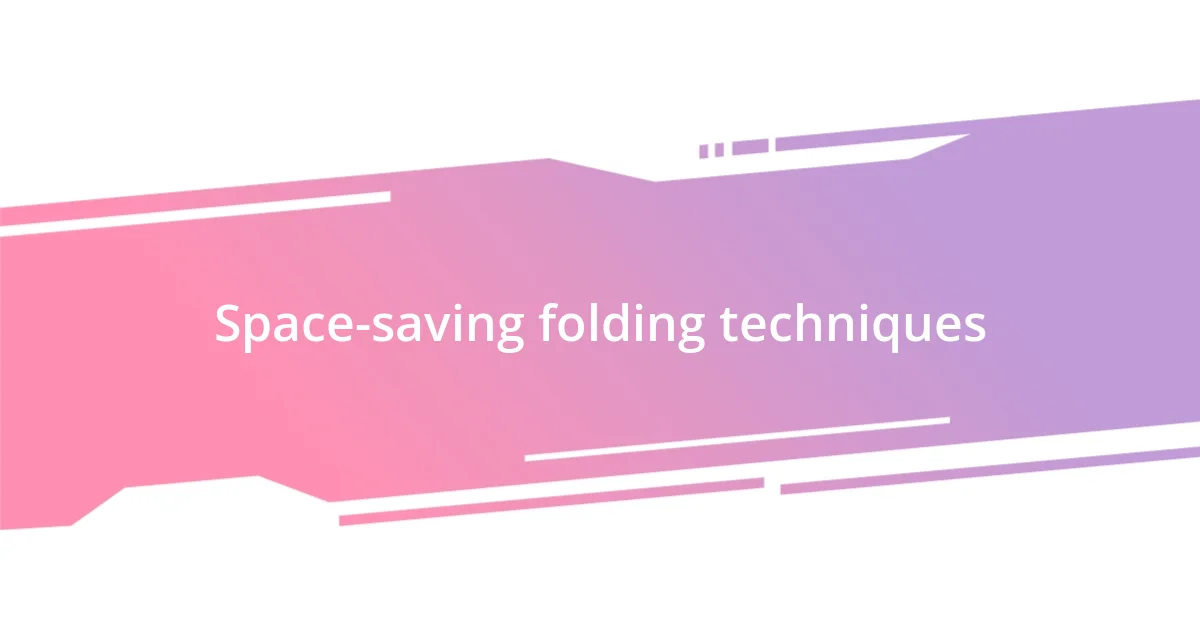
Space-saving folding techniques
When I discovered effective folding techniques, it was like I had finally unlocked the ultimate puzzle in packing. For instance, my go-to method is the “Marie Kondo” technique, where I fold clothes into neat rectangles. This not only saves space but also allows me to stack clothes vertically in my suitcase, making it easy to see everything at a glance. I vividly remember a trip where I had managed to fit a week’s worth of outfits in just one carry-on, all thanks to this incredible folding method.
To maximize your packing efficiency, here are some folding techniques that have worked wonders for me:
- Rolling: Roll clothes tightly to save space and reduce wrinkles.
- Folding vertically: Fold items into rectangles and stack them, allowing for easy visibility.
- Bundle wrapping: Layer clothes around a core item, which minimizes creasing and maximizes space.
- Stuffing: Use softer items, like socks or t-shirts, to fill gaps and protect fragile items.
I still get excited recalling the moment I opened my suitcase and realized there was room for those last-minute items I wanted to bring back! These techniques have transformed packing from a frustrating chore into a strategic art form.
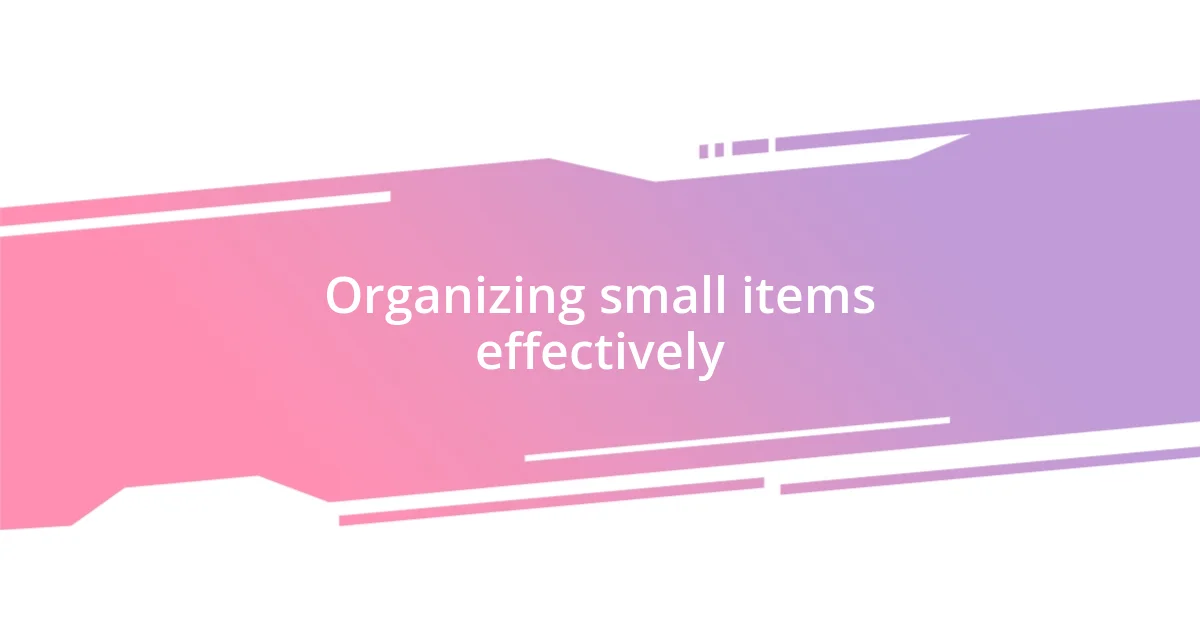
Organizing small items effectively
When it comes to organizing small items, I’ve found that little compartments can be a game changer. For instance, I often use small, clear toiletry bags to keep my chargers, cords, and earphones separated. Imagine rummaging through a messy bag trying to find your headphones just when you need them most—frustrating, right? Having them neatly stored means I can grab what I need without the fuss.
I also love using pill organizers for my jewelry when I travel. Each compartment is the perfect size for rings, earrings, or even delicate chains. This method prevents tangling and losing pieces in the abyss of my suitcase. I once had a gorgeous necklace break because it got tangled up with my other accessories—never again! This creative storage solution allows me to not only keep my items safe but also to pick my outfits with ease, adding a bit of excitement to my travel routine.
Moreover, I started using old glasses cases for small items like lip balm, hair ties, or even sewing kits. The sturdy structure protects these essentials, and it feels rewarding to repurpose something that might otherwise gather dust. What’s more satisfying than knowing you’ve minimized waste while simplifying your packing? I still chuckle when I see my friends’ puzzled faces as I pull out my “magic” case filled with all my little necessities!
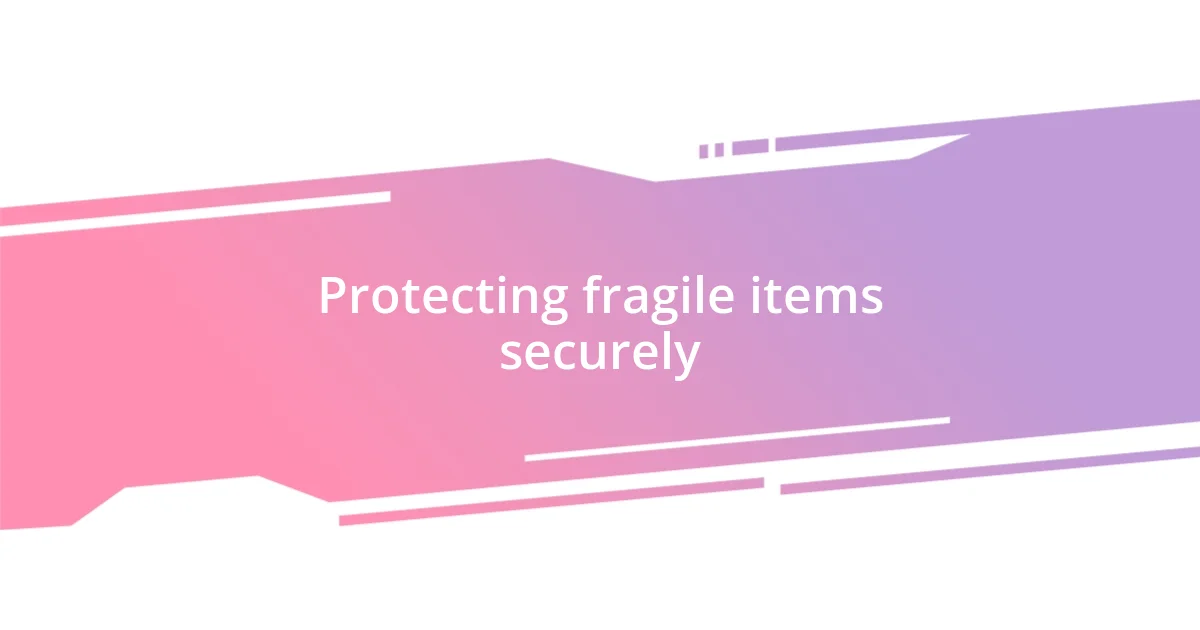
Protecting fragile items securely
When it comes to securing fragile items, I can’t stress enough how important it is to use the right materials. I’ve made the mistake of skimping on bubble wrap before, only to find a treasured vase shattered upon arrival. Since then, I always ensure I wrap each delicate item in multiple layers of bubble wrap and complement it with packing paper for extra cushioning. I remember that one time I packed a glass figurine—I was so nervous, imagining it breaking in transit, but by using both bubble wrap and foam peanuts, it arrived in perfect condition.
Another trick I’ve learned is to use towels or clothing to create a protective layer around fragile items. It’s incredible how a simple towel can add that extra buffer. Once, I had to transport a set of vintage wine glasses. I carefully nestled them in my softest towels, rolling them up tightly, and placed them securely in the center of my suitcase. Not only did this maximize space, but it also provided an extra sense of calm knowing they were well-protected. Have you ever thought about utilizing everyday items for packing? It’s an effortless way to enhance the safety of your fragile belongings while being eco-friendly.
Lastly, I can’t emphasize the importance of labeling fragile items clearly. In my early packing days, I often overlooked this detail. Now, I stick bright “fragile” labels on boxes and suitcases, making it unmistakable to both myself and anyone handling my luggage. Once, I witnessed baggage handlers tossing bags without a second thought—but my labeled boxes were handled with care. It’s a simple act that makes a world of difference in ensuring that your fragile treasures arrive safely at their destination.
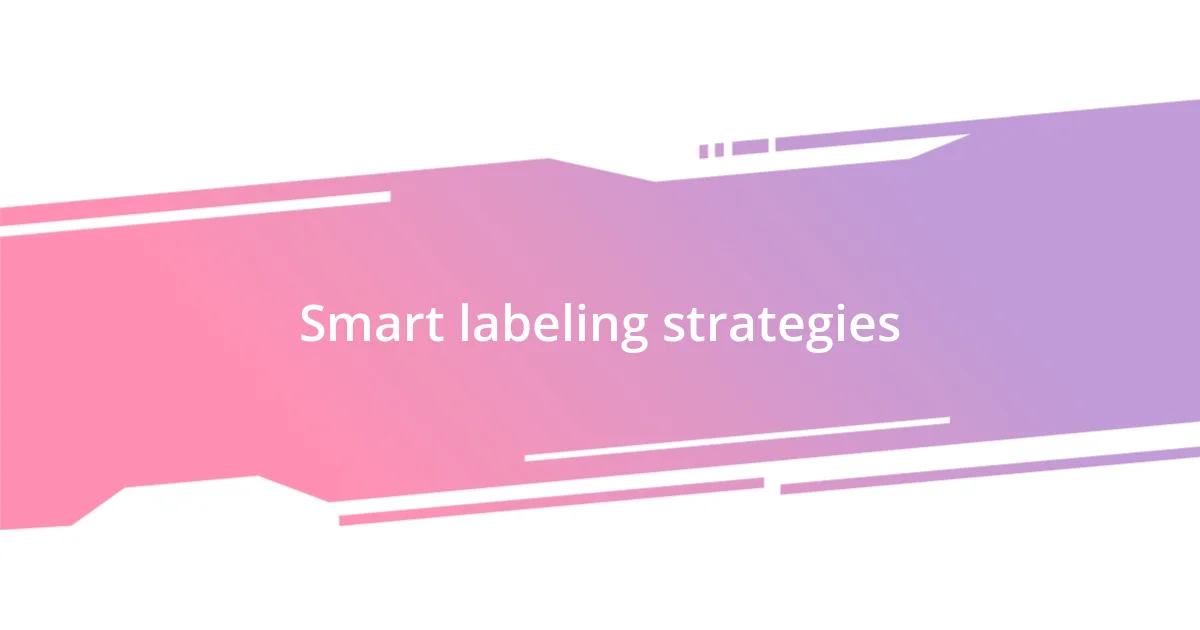
Smart labeling strategies
When it comes to smart labeling strategies, I’ve discovered that color-coding can be a lifesaver. For instance, when preparing for a trip, I use different colored labels for various categories—blue for clothing, green for toiletries, and red for electronics. This method not only streamlines the packing process but also makes it easy to find what I need at a glance. I remember the first time I tried this; I was amazed at how quickly I could unpack and settle in without feeling overwhelmed.
Another tactic I find invaluable is making specific labels for individual bags. I once took a week-long camping trip and labeled each bag with its contents, like “cooking supplies” or “first aid kit.” Not only did it save time, but it also gave me a sense of reassurance, knowing that everything was organized and accessible. Have you ever been in a situation where you couldn’t find something essential? It’s a feeling I’ve learned to avoid through this simple yet effective labeling practice.
Don’t underestimate the power of detailed notes on your labels! I started including not just titles but also expiration dates on my food items and a checklist of essentials on my travel bags. This way, I can easily keep track of what I have and what I might still need to pack. I remember heading out for a road trip and realizing too late that I didn’t bring a crucial charger. Now, with my thorough labels, I can confidently pack knowing I won’t forget those little yet important items. Who doesn’t want that peace of mind while on the road?
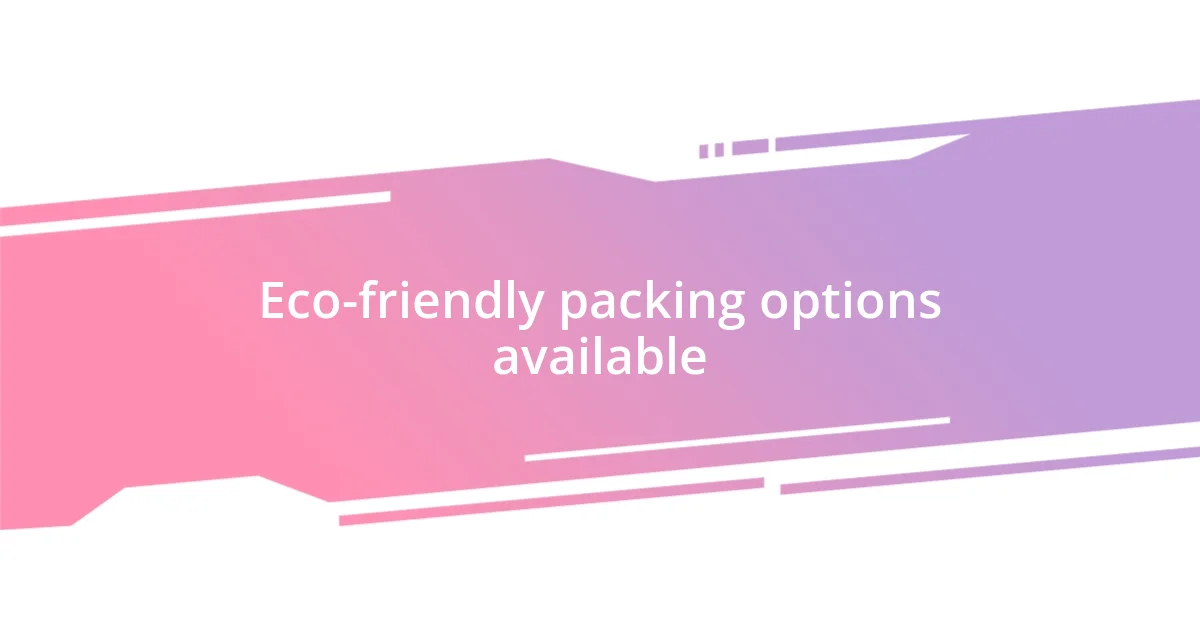
Eco-friendly packing options available
When exploring eco-friendly packing options, I’ve found that using biodegradable materials is a game changer. For instance, I often opt for packing peanuts made from cornstarch instead of traditional foam ones. The first time I used them, I was pleasantly surprised to discover they dissolve in water! It felt great to know that I was making a choice that wouldn’t harm the environment. Have you ever considered how simple swaps can help reduce your carbon footprint?
Reusing boxes and packing materials is another sustainable practice that I swear by. It might sound mundane, but every time I flatten a box from a previous delivery, I feel proud of myself for reducing waste. I recall moving to a new apartment and utilizing old shoe boxes to pack fragile items. Not only did it give those boxes a second life, but it saved me money on new supplies. It’s amazing how a little creativity can lead to eco-friendly solutions!
Finally, I love using recycled paper instead of bubble wrap. I’ll crumple up old newspapers and use them to cushion my glassware. The tactile experience of packing while knowing I’m being kind to our planet adds a touch of joy to the process. There’s something satisfying about turning something that would have been discarded into a valuable packing material. Have you ever tried that feeling of transforming waste into something useful? It’s a small change that makes a significant impact!
